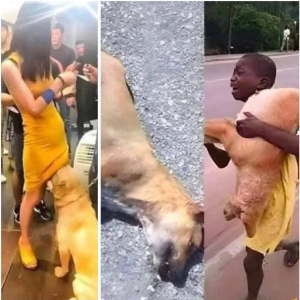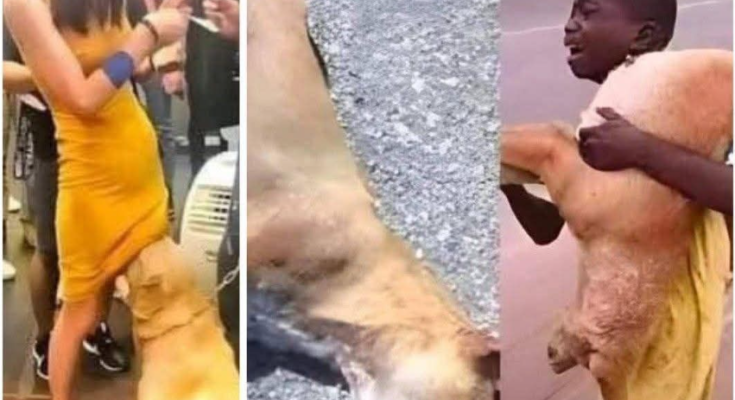Why Your Dog Sniffs Your Genital Area — The Real Scientific Explanation
Many dog owners have experienced that awkward moment when their furry friend walks up and — without hesitation — starts sniffing their crotch. While it can feel uncomfortable or embarrassing, this behavior is completely natural for dogs. In fact, it tells us a lot about how dogs communicate, understand the world, and interact with humans.
Despite popular myths, it’s not a sign that there’s “something wrong” with you. It’s simply your dog’s way of gathering information, much like a human might shake hands or ask questions.
1. Dogs Explore the World Through Smell
Dogs have an extraordinarily powerful sense of smell — far more sensitive than humans. Scientists estimate that a dog’s nose is between 10,000 and 100,000 times more sensitive than a human’s.
Where humans primarily rely on sight, dogs rely on scent to identify people, places, and other animals. Every person carries a unique “scent signature,” and one of the most information-rich areas of the body is the genital and groin region.
This is because the human body releases pheromones — chemical signals that communicate biological information — through sweat glands, particularly in the armpits and groin area.
2. Pheromones: Your Body’s Invisible Messages
Pheromones are natural chemicals that convey subtle information about your body, including hormonal changes, emotional state, reproductive status, and even stress levels.
Dogs are especially good at detecting pheromones through a special structure in their noses called the vomeronasal organ (also known as Jacobson’s organ). This organ is located between a dog’s nasal cavity and mouth, allowing them to pick up chemical cues that humans can’t perceive.
When your dog sniffs your groin area, they are picking up these pheromone signals. It’s a way for them to learn about who you are, how you’re feeling, and even what might be changing in your body.
3. Why Dogs Target the Genital Area Specifically
In both animals and humans, the groin area is rich in apocrine glands, which produce pheromone-heavy sweat. These glands are concentrated around the genitals and armpits. Because of this, the genital region carries some of the strongest chemical signals your body emits.
In the dog world, sniffing another dog’s rear end is a normal greeting ritual — it tells them everything from age to reproductive status to health. When dogs do the same thing to humans, they’re basically trying to say hello in their own language.
4. Dogs Can Smell Hormonal and Physical Changes
Dogs can detect changes in hormones such as estrogen, progesterone, testosterone, and cortisol. This means they may be more interested in sniffing:
-
Women during ovulation, menstruation, or pregnancy.
-
People who are sweating more than usual.
-
People who are under stress or feeling anxious.
-
Individuals who have recently exercised.
For example, if someone is pregnant, their body chemistry changes significantly. Many dog owners report their pets acting more curious or affectionate during this time. It’s not magic — it’s biology.
5. Medical Conditions Dogs Can Detect
Dogs have also been trained to detect certain medical conditions through scent, such as:
-
Diabetes mellitus (by smelling changes in blood sugar levels)
-
Cancer (through chemical changes in breath or sweat)
-
Hormonal disorders
-
Infections
This doesn’t mean your dog sniffing your crotch is a medical diagnosis — it’s usually just curiosity. But it does highlight how powerful their sense of smell really is.
6. When the Behavior Becomes Persistent
Most dogs sniff once and move on. But sometimes, a dog may repeatedly try to sniff the same area, which can be uncomfortable for the person. Common reasons for this include:
-
The person is producing stronger pheromone signals (due to hormones, stress, or exercise).
-
The dog is anxious or overexcited.
-
Lack of proper training and boundaries.
-
The dog associates the behavior with attention (even if it’s negative).
In these cases, the behavior isn’t dangerous — but it can be managed through gentle training.
7. How to Manage or Redirect the Behavior
If you or someone else feels uncomfortable, you can teach your dog polite greeting manners. Here are a few effective approaches:
-
Train “sit” or “stay” commands when greeting new people.
-
Redirect their nose to your hand or their toy.
-
Reward calm behavior rather than giving attention when they sniff inappropriately.
-
Use positive reinforcement, not punishment. Yelling or scolding can make the dog confused or anxious.
Over time, dogs can learn to greet humans without sticking their nose in personal areas.
8. Cultural Embarrassment vs. Animal Instinct
For humans, this behavior feels personal or even invasive because of cultural norms about privacy. But for a dog, it’s the equivalent of a handshake or a friendly introduction. They don’t mean to embarrass anyone — they’re simply being dogs.
Children often laugh or feel awkward when a dog sniffs them. Adults may step back in discomfort. Understanding what the behavior really means can help ease that tension and encourage calm, confident handling.
9. When to Consult a Veterinarian or Trainer
Occasional sniffing is normal. But if your dog suddenly starts showing excessive sniffing or licking behavior toward a particular person, it can sometimes be linked to:
-
Anxiety or stress in the dog.
-
Underlying medical issues (if accompanied by other behavior changes).
-
Reinforced habits from a lack of boundaries.
In these cases, a professional trainer or veterinarian can help assess and address the situation.
10. Turning an Awkward Moment Into a Teachable One
While it may feel embarrassing, your dog’s interest in your groin area is a sign of trust and bonding. They view you as part of their “pack” and want to know everything about you — through their most powerful sense.
Many dog trainers recommend using these moments as opportunities to reinforce positive behavior, rather than getting upset or punishing the dog. Calmly redirecting them shows leadership and helps them understand your boundaries.
Key Takeaways
-
Dogs sniff the genital area because of the high concentration of pheromones there.
-
It’s a completely natural and instinctive behavior, not a sign of disrespect or illness.
-
Dogs can detect hormonal changes, stress levels, and even medical conditions through smell.
-
The behavior can be managed with gentle training and redirection.
-
Understanding their instincts can help reduce embarrassment and strengthen the bond between you and your dog.
Final Thoughts
Your dog’s nose is their window to the world. While sniffing the groin might make humans blush, for dogs it’s a normal and essential way of getting information. Instead of feeling embarrassed, understanding why they do it can help you handle the situation confidently and kindly.
Setting boundaries through training can ensure everyone — humans and dogs alike — feels comfortable. In the end, this behavior isn’t a sign of anything “wrong” with you. It’s just your dog saying: “Hey, I know you. You’re part of my pack.”

